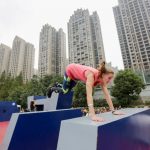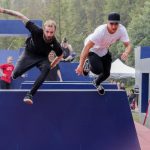Lausanne, Jan 29, 2018: Launching competitions, implementing a vast educational component and undertaking field work on a worldwide scale: 2018 is certainly a year of action for Parkour, some 11 months on from its arrival within the International Gymnastics Federation (FIG) International Parkour Federation.
“2018 is the year in which we must cement the work that has been done since our rapprochement with the FIG. Milestones will be set through the implementation of educational programmes, links between the world of Parkour and the Gymnastics family will be strengthened and the World Cups will be officially launched,” said Charles Perrière, Vice President of the FIG Parkour Commission.
A Promising partnership with IPF
The FIG has always been open to collaboration with any international organisation interested in developing Parkour. Thus, a meeting was held on 23 January with representatives of the IPF (International Parkour Federation), one of the major players in the promotion of Parkour, at the FIG headquarters. In the wake of very positive discussions, a Memorandum of Understanding was signed laying the foundations for a promising collaboration on the development of Parkour. (See press release of 27 January)
Establishment of a regulatory framework
The FIG had to update certain regulations and put new ones in place in order to provide a legal framework for the development of Parkour within the Federation. The FIG therefore published in December 2017:
• FIG Statutes updated to include Parkour
• FIG Technical Regulations including Parkour in the “General Rules” section
• and a dedicated “Special Regulations for Parkour” section
• Parkour World Cup Rules
• Parkour Code of Points
These rules are effective from 1 January 2018.
First World Cup series in 2018
After two test events in Montpellier (FRA) on 28 May and in Chengdu (CHN) on 4 and 5 November 2017 the FIG is preparing to launch a series of three-stage World Cups in April 2018. They will be held in Hiroshima (JPN), Montpellier (FRA) and Chengdu (CHN) as part of the FISE Action Sports Festivals, as was the case for both test events.
“For us, competition is not a goal in its own right but a multi-faceted showcase that helps raise Parkour’s profile and allows us to reach new audiences through the introductory initiatives and workshops, which take place on the fringes of all our events,” said Perrière. “In recent years a number of different Parkour-inspired competitions have flourished and therefore, we prefer to satisfy the needs of those who love competitive Parkour by offering them a format which respects the fundaments of our sport.”
And he notes that, “The success of the two events that we organised in Montpellier and Chengdu surprised even ourselves. We have seen real enthusiasm from the public which is very, very encouraging for the future.”
The first two World Cup series in 2018 and 2019 set the stage for the first World Championships in 2020, which will then be held biennially on even years.
The ultimate goal is to integrate Parkour within the Olympic programme by 2024 at the earliest. “The Olympic Games is the most beautiful sporting showcase we could have. It would be great for us to achieve this recognition, and where better than in Paris, where Parkour was born and bred,” said Perrière.
Education Programmes
At the same time, the Parkour Commission is working on developing a training curriculum for practitioners, supervisors and judges. Basic courses will be offered from spring 2018, in different languages, in each continent. Once they have acquired the basic knowledge, judges and supervisors will be able to undertake further training, which will be rolled out starting in the second half of 2018.
This education component is one of the Parkour Commission’s leading projects, aiming to develop a strong network of certified educators worldwide to guarantee healthy and gradual practice of the sport.
In this area, Parkour can certainly count on the FIG’s experience. Since 2002, thousands of coaches from regions that do not currently have a great tradition in Gymnastics have taken part in the Academies programme, gaining an understanding of the levels of progression that are necessary in order to protect the physical and psychological development of young athletes.
From a global to a national level
The rapprochement that the FIG and the Founders of Parkour have achieved on a global level should now serve as an incentive for the same to take place on a national level. To this end, the Parkour Commission will soon present a range of possible collaboration models to encourage national Gymnastics federations and Parkour associations to work together to find winning strategies.
These collaborations may take various forms, as is already the case for Gymnastics sports. In some countries, Artistic Gymnastics, Rhythmic Gymnastics, Trampoline Gymnastics, Acrobatic Gymnastics and Aerobic Gymnastics are each governed by different national federations. Conversely, in other countries, all these sports are managed by one single national federation. Some have already successfully incorporated a Parkour section in recent years, and this may indeed serve as an example to others. —- FIG





Leave a Reply
You must be logged in to post a comment.